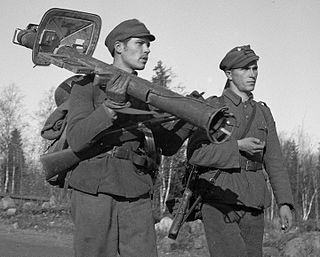
The Finnish Army is the land forces branch of the Finnish Defence Forces. The Finnish Army is divided into six branches: the infantry, field artillery, anti-aircraft artillery, engineers, signals, and materiel troops. The commander of the Finnish Army since 1 January 2022 is Lieutenant General Pasi Välimäki.

Ernst Ruben Lagus, better known as Ruben Lagus, was a Finnish major general, a member of the Jäger Movement and the recipient of the first Mannerheim Cross. He participated in the Eastern Front of World War I as a volunteer of the 27th Royal Prussian Jäger Battalion, in the Finnish Civil War as battalion commander and as a supply officer in the Winter War. During the Continuation War, he commanded an armoured brigade, later division, which had a significant role in the influential Battle of Tali-Ihantala.

The Polish II Corps, 1943–1947, was a major tactical and operational unit of the Polish Armed Forces in the West during World War II. It was commanded by Lieutenant General Władysław Anders and fought with distinction in the Italian Campaign, in particular at the Battle of Monte Cassino. By the end of 1945, the corps had grown to well over 100,000 soldiers.

The Guards Armoured Division was an armoured division of the British Army during the Second World War. The division was created in the United Kingdom on 17 June 1941 during the Second World War from elements of the Guards units, the Grenadier Guards, Coldstream Guards, Scots Guards, Irish Guards, Welsh Guards, and the Household Cavalry.
The 6th Division was a unit of the Finnish Army during the Continuation War. Subordinated to the German XXXVI Corps, the division took part in the German-led Operation Arctic Fox in 1941. In 1943, the division was moved to Eastern Karelia, from where it was moved to the Karelian Isthmus following the start of the 1944 Soviet Vyborg–Petrozavodsk offensive. Following the Moscow armistice, the division also took part in the Lapland War against the German forces remaining in Finnish Lapland.

The 4th Infantry Division was a regular infantry division of the British Army with a very long history, seeing active service in the Peninsular War and Waterloo Campaign, the Crimean and Boer Wars and both World Wars. It was disbanded after the Second World War and reformed in the 1950s as an armoured formation before being disbanded and reformed again and finally disbanded on 1 January 2012.

The Battle of Honkaniemi was fought between Finnish and Soviet forces on 26 February 1940. This battle was notable for being fought by tanks, the only time they were used en masse in combat by Finnish forces in the Winter War.

Kainuu brigade is a Finnish Army unit situated in Kajaani. The brigade is one of the biggest army units, training approximately 4000 conscripts annually. The Kainuu Brigade is one of the three readiness brigades in the Finnish Army. The brigade trains troops for war-time Kainuu Jäger Brigade.

The Battle of Vuosalmi – the main bulk of it – lasted from July 4 to July 17, 1944. It was fought during the Continuation War (1941–1944), a part of World War II, between Finland and the Soviet Union.

The Battle of Tornio was the first major engagement between Nazi Germany and Finland in the Lapland War; although hostilities had already begun elsewhere.

The 4th Ukrainian Front was the name of two distinct Red Army strategic army groups that fought on the Eastern Front in World War II.

The 9th Armoured Division was an armoured division of the British Army, raised during the Second World War. It never saw active service during the war as a complete division.

Parola Tank Museum, officially Armoured Vehicle Museum is a military museum located 110 kilometres north of Helsinki in Parola, near Hämeenlinna, Finland, a few kilometres from the Finnish Army Armoured Brigade training unit. It displays various tanks, armoured vehicles and anti-tank guns used by the Finnish Defence Forces throughout their history, including their latest Leopard 2A4 tank. A rare exhibit is an armoured train used in World War II. The museum was opened on June 18, 1961, when there were 19 tanks and 12 anti-tank guns on display.

The Northumberland Hussars was a Yeomanry regiment of the British Army, transferred to the Royal Artillery for the duration of the Second World War. It was disbanded as an independent Territorial Army unit in 1967, a time when the strength of the Territorial Army was greatly reduced. The regiment's name lives on in the title of the command and support squadron of the Queen's Own Yeomanry (QOY), a Formation Reconnaissance Regiment based in Newcastle upon Tyne.

This is a sub-article to Battle of Narva (1944).
During the Second World War the British Army deployed armoured divisions and independent armoured and tank brigades.

Though nearly obsolete by the beginning of World War II, the T-26 was the most important tank of the Spanish Civil War and played a significant role during the Battle of Lake Khasan in 1938 as well as in the Winter War. The T-26 was the most numerous tank in the Red Army's armoured force during the German invasion of the Soviet Union in June 1941. The Soviet T-26 light tanks last saw combat in August 1945, in Manchuria.

The Battle of Tali–Ihantala was part of the Finnish-Soviet Continuation War (1941–1944), which occurred during World War II. The battle was fought between Finnish forces—using war materiel provided by Germany—and Soviet forces. To date, it is the largest battle in the history of the Nordic countries.


















